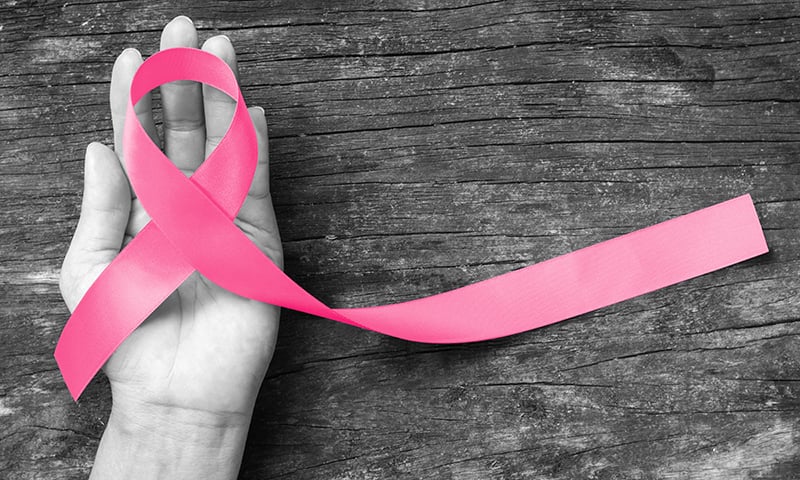October is recognised worldwide as Breast Cancer Awareness Month.
Nearly one in eight women in Pakistan is diagnosed with breast cancer during their lifetime. Most people have at least one loved one who has succumbed to breast cancer.
On a positive note, recovery is possible if it is detected and treated in its early stages. However, this can only be accomplished when we realise the importance of breast self-examination (BSE), clinical breast examination (CBE) and mammograms (X-rays of the breasts).
This month is a good reminder to spread awareness.
BSE is easy and does not require professional expertise. Regular BSE can increase the chances of early detection, which ultimately results in a higher chance of survival.
The best time to perform a breast self-examination is immediately after you finish your monthly period. A step-by-step guide is given below.
In addition, an annual breast exam by your family physician is recommended for all women after the age of 20. This offers an opportunity for young women to have an open conversation with their doctor regarding their body and sexuality.
Annual screening mammograms are recommended at age 40 and above.
Women younger than 40 who have a family history or other risk factors for breast cancer should discuss their risks and an appropriate screening schedule with their physician, as the screening timeline may differ.
A simple step-by-step guide to a breast self-examination
Step 1: Begin by looking at your breasts in the mirror with your shoulders straight and your arms on your hips. You should be looking out for:
- any changes in breast size, shape, colour or any visible swellings
- any dimpling or puckering of the skin, changes in nipple shape (inverted), any redness or pain.
Step 2: Now, raise your arms and look for the same changes.
Step 3: While you're at the mirror, look for any signs of fluid coming out of one or both nipples (this could be a watery, milky or yellow fluid, or blood).
Step 4: Next, feel your breasts while lying down, using your right hand to feel your left breast and then your left hand to feel your right breast.
Use a firm, smooth touch with the first few finger pads of your hand, keeping the fingers flat and together. Use a circular motion, about the size of a Rs5 coin.
Follow a pattern to be sure that you cover the whole breast. You can begin at the nipple, moving in larger and larger circles until you reach the outer edge of the breast.
Be sure to feel all the tissue from the front to the back of your breasts. Gently pinch each nipple between thumb and index finger for any secretions.
Step 5: Finally, feel your breasts while you are standing or sitting. Many women find that the easiest way to feel their breasts is when their skin is wet and slippery, so this step can be done in the shower. Cover your entire breast, using the same hand movements described in step 4.
BSE can help women identify changes in their breasts which may not be detected otherwise.
Most lumps are often non-sinister, but the possibility of picking up a cancerous lump is enough incentive to encourage women to learn how to perform a breast self-examination.
Self-examination also provides a sense of empowerment to women that they can actively take part in taking care of their own health.
It is important to remember that BSE in no way replaces the annual mammogram screening which still should be done as indicated.
Myths and facts
Like any worrisome diagnosis, breast cancer is not free of its associated myths, the most common ones being:
1. ‘Most breast cancer runs in the family’
Most cases of breast cancer happen by chance and not because of a family history. Only 5-10pc of breast cancers are caused by inheriting an altered gene.
2. ‘The first sign of breast cancer is always a lump’
A lump is only one of several possible symptoms of breast cancer and not everyone with breast cancer has a noticeable lump.
Most breast changes are likely to be normal or due to a benign (not cancerous) breast condition, but it’s still important to get them checked; this is where a clinical breast exam and annual mammograms come in.
3. ‘All women with breast cancer will need a mastectomy’
There are several treatment modalities for breast cancer based on the type and severity. The best one for a particular patient is decided by them and their cancer specialist.
4. ‘There is nothing that can be done to lower the risk of developing breast cancer’
Lifestyle and environmental factors can have an impact on breast cancer risk. To lower your risk, it is vital to maintain a healthy lifestyle with weight management, exercise and a low intake of saturated fat.
5. ‘Men cannot get breast cancer because they don’t have breasts’
Men can get breast cancer, albeit rarely. Both men and women have breast tissue, although men have much smaller amounts than women.
Breast self-examination is encouraged by doctors but public awareness and training in the use of this important screening tool needs to be increased.
Suffice to say, as women become confident in performing breast self-exams and go to their doctors for annual clinical breast exams and mammograms, we will be able to bring about a positive and much needed change.
Together, we can fight breast cancer.
Are you a breast cancer survivor? Share your experiences with us at blog@dawn.com
















































